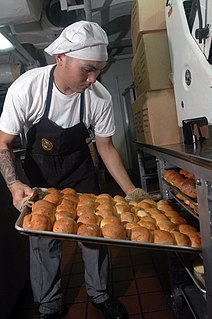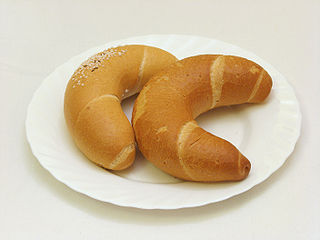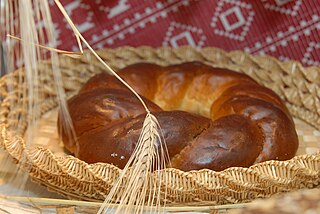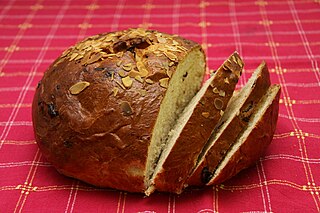
Gebildbrot is a bread or pastry in forms of figurative representations, such as a human, hare, bird or other braidings of dough. Traditionally this pastry is made for and consumed on certain feasts [1] of the liturgical year.

Gebildbrot is a bread or pastry in forms of figurative representations, such as a human, hare, bird or other braidings of dough. Traditionally this pastry is made for and consumed on certain feasts [1] of the liturgical year.
In early forms of funeral feasts, spiced breads were eaten at funerals to ward off evil spirits.
The term Gebildbrot (from the German word for "shaped bread") was used first by the German historian and folklorist Ernst Ludwig Rochholz (1809-1892). The German Folklore Dictionary, published in 1974, is already critical of such opinions of the “popular mythologists of the 19th century”, although it gives a detailed account of them. Rather, one should reckon with the "personal drive to sculpt the manufacturer and with baker's whims" or the requirements of the baking process (perforation, splitting).
Most common pastries are made from yeast dough, which has been traceable since the 15th century. Around 1700 there were yeast cultivations, which were primarily aimed at the needs of beer brewers and schnapps distillers and were not very suitable for bakers. It was not until the 19th century that new brewery technologies made sufficient baker's yeast available. From this alone, the pre-Christian cultic theories lead ad absurdum.


A baker is a tradesperson who bakes and sometimes sells breads and other products made of flour by using an oven or other concentrated heat source. The place where a baker works is called a bakery.

A bun is a small, sometimes sweet, bread-based item or roll. Though they come in many shapes and sizes, they are most commonly hand-sized or smaller, with a round top and flat bottom.

A hot cross bun is a spiced sweet bun usually made with fruit, marked with a cross on the top, and traditionally eaten on Good Friday in the United Kingdom; Ireland; Australia; India; New Zealand; South Africa; and some parts of the Americas, including Canada and the United States.

Dough is a thick, malleable, sometimes elastic paste made out of any grains, leguminous or chestnut crops. Dough is typically made by mixing flour with a small amount of water and/or other liquid, and sometimes includes yeast or other leavening agents as well as other ingredients such as various fats or flavorings.

A semla, vastlakukkel, laskiaispulla or fastlagsbulle/fastelavnsbolle is a traditional sweet roll made in various forms in Sweden, Finland, Estonia, Norway, Denmark, the Faroe Islands and Iceland, associated with Lent and especially Shrove Tuesday in most countries, Shrove Monday in Denmark, parts of southern Sweden, Iceland and Faroe Islands or Sunday of Fastelavn in Norway. In Sweden it is most commonly known as just semla, but is also known as fettisdagsbulle. In the southern parts of Sweden, as well as in Swedish-speaking Finland, it is known as fastlagsbulle. In Estonia it is called vastlakukkel. In Norway and Denmark it is called fastelavnsbolle. In Iceland, it's known as a bolla and served on Bolludagur. In Faroe Islands it is called Føstulávintsbolli, and is served on Føstulávintsmánadagur. Semla served in a bowl of hot milk is hetvägg.

A gingerbread house is a novelty confectionery shaped like a building that is made of cookie dough, cut and baked into appropriate components like walls and roofing. The usual material is crisp ginger biscuit made of gingerbread – the ginger nut. Another type of model-making with gingerbread uses a boiled dough that can be moulded like clay to form edible statuettes or other decorations. These houses, covered with a variety of candies and icing, are popular Christmas decorations.

A Berliner Pfannkuchen is a German doughnut with no central hole, made from sweet yeast dough fried in fat or oil, with a marmalade or jam filling like a jelly doughnut, and usually icing, powdered sugar or conventional sugar on top. They are sometimes made with chocolate, champagne, custard, mocha, or advocaat filling, or with no filling at all.

Kifli or kipfel is a traditional yeast bread roll that is rolled and formed into a crescent before baking.

Czech cuisine has both influenced and been influenced by the cuisines of surrounding countries and nations. Many of the cakes and pastries that are popular in Central Europe originated within the Czech lands. Contemporary Czech cuisine is more meat-based than in previous periods; the current abundance of farmable meat has enriched its presence in regional cuisine. Traditionally, meat has been reserved for once-weekly consumption, typically on weekends. The body of Czech meals typically consists of two or more courses; the first course is traditionally soup, the second course is the main dish, and the third course can include supplementary courses, such as dessert or compote. In the Czech cuisine, thick soups and many kinds of sauces, both based on stewed or cooked vegetables and meats, often with cream, as well as baked meats with natural sauces (gravies), are popular dishes usually accompanied with beer, especially Pilsner, that Czechs consume the most in the world. Czech cuisine is also very strong in sweet main courses and desserts, a unique feature in European cuisines.

Kalach, kalács, kolach, kolač, or colac, is a traditional Eastern European bread, commonly served during various ritual meals. The name originates from the Old Slavonic word kolo (коло) meaning "circle", "wheel".

Tsoureki also known as شوريك (Arabic), choreg or "chorek", çörək (Azerbaijani), çyrek (Albanian), kozunak, cozonac (Romanian) or paskalya çöreği (Turkish) is a sweet holiday bread made with flour, milk, butter and sugar and commonly seasoned with orange zest, mastic resin or mahlab. One variation commonly called "Easter bread" is made by Greek communities during Easter, not only in Greece, but also in other countries with Greek communities. It is also sometimes called Armenian Easter bread.

Cozonac or Kozunak is a special sweet leavened bread, traditional to Romania, Bulgaria and Serbia. Rich in eggs, milk and butter, it is usually prepared for Easter in Bulgaria, and mostly for every major holiday in Romania and Moldova. The name comes from Greek: ϰοσωνάϰι kosōnáki, a diminutive form of ϰοσώνα kosṓna.

Birnbrot or Birnweggen are a traditional pastry originating in Switzerland with a filling of dried pears. They exist throughout Switzerland and popular variations include "Bündener Birnbrot", "Glarner Birnbrot", "Toggenburger Birnbrot" (from Toggenburg and "Luzerner Birnweggen".

Allerheiligenstriezel or simply Strietzel is a braided yeast pastry. Its name means "All Saints' braid" in English and it consists of flour, eggs, yeast, shortening or butter, raisins, milk, salt, and decorating sugar or poppy seeds. Some regional variations also include rum or lemon juice.
The third series of The Great British Bake Off began airing on Tuesday 14 August 2012. The series was filmed at Harptree Court in East Harptree, Somerset.

A Heißwecke, HICE-veck-ə,, also called a Heißewecke or Hedewig, is a traditional type of currant bun that goes back, within the German-speaking region of Europe, at least to the Late Middle Ages. In North and Northwest Germany it is eaten before the beginning of the pre-Easter fasting period known as Lent, especially from Rose Monday (Rosenmontag) to Ash Wednesday (Aschermittwoch). It is basically a sweet bread roll made with milk and wheat flour that is eaten hot, hence the name: Heißwecken literally means "hot rolls". Heißwecken are predominantly eaten in the area influenced by the Hanseatic League i.e. most of northern Europe from what is now the Netherlands to Poland and the Baltic Sea coast. It has numerous dialectical names that are almost all derived from the term Heißwecken. The most common are Hedewäggen, Hetwegge, Heiteweggen and Heetwich.